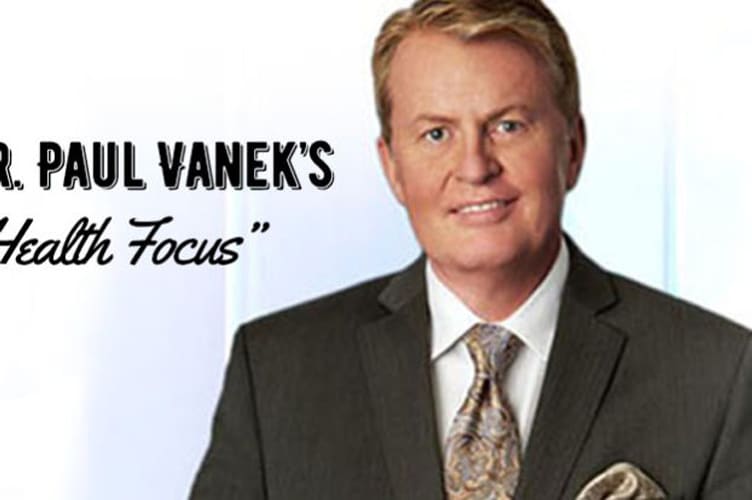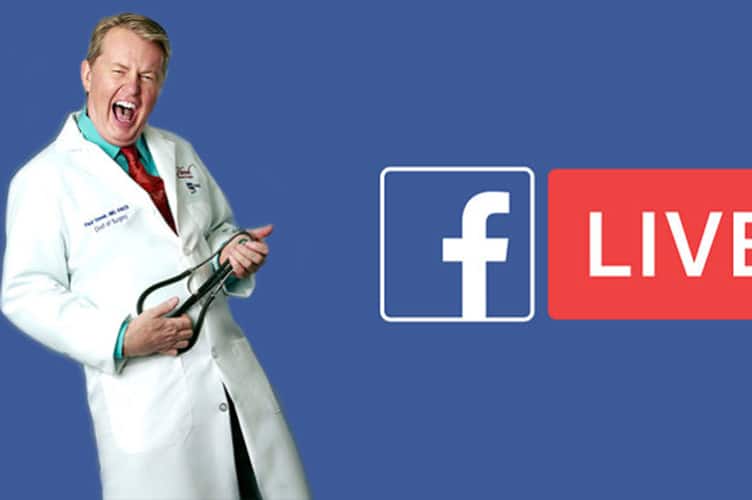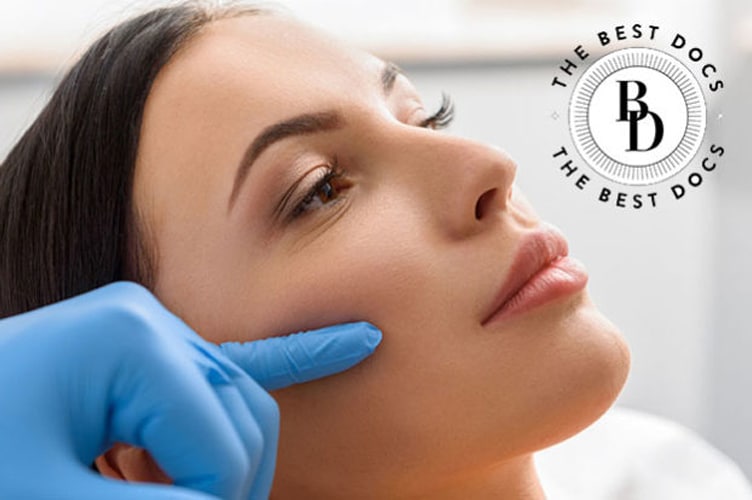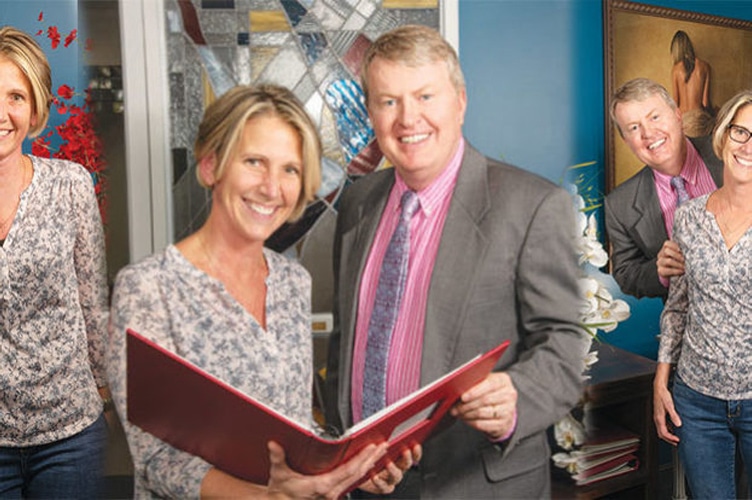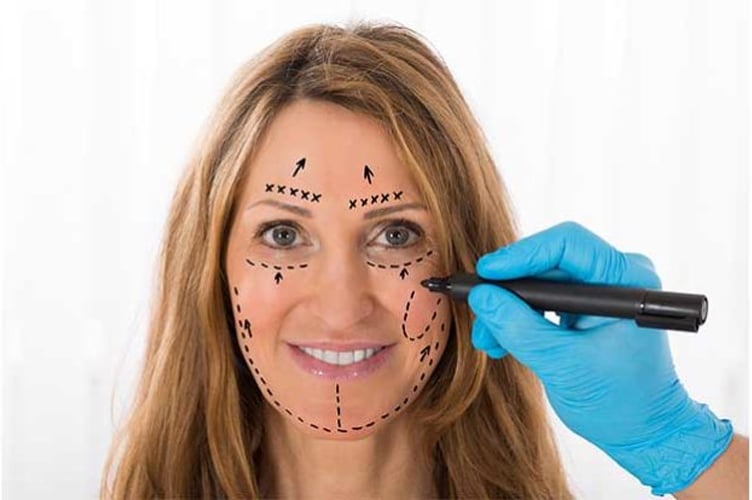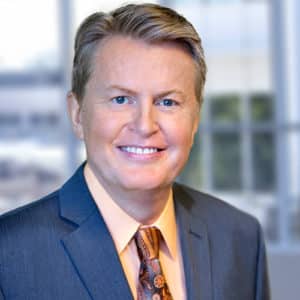Transcription from the September Facebook Live with Dr. Vanek:
– Hey, welcome to Facebook Live. I’m Doctor Paul Vanek. Welcome to Facebook Live, still Paul Vanek.
So if you like your content on Instagram and Facebook, I’d like you to click or share. We’re going to spend the next 30 minutes, share with anyone who’s interested in our live event. I’m going to host you the next 30 minutes and I’m looking forward answering your questions that come through either on Instagram or Facebook. So, Paul Vanek, Mentor Plastic Surgery.
Our first question comes from Nicole. Says, “What is the best kind of bras to wear “after a lift and augmentation?”
My practice, when I perform a breast augmentation with a lift, I typically have a patient on day one after surgery to go into a front clasp sports bra. And the reason I do that is, I don’t really want you to do too much arm exercises right away but eventually we’ll get your arms limbered up in a few days after surgery. Front clasp is convenient because you don’t have to try to put your arms over your head. Number two, it gives a light compression, and so with the incisions for the lift have Steri-Strips or technology dressings on them, they don’t interfere in any way, taking them on and off. I typically let my patients shower one day after a breast augmentation or one day after a breast lift surgery because the incisions will seal themselves in about a day or so after the surgery. So I’ll see you the next day after surgery, take you out of an ACE wrap that’s not cranked on your body and then have you have a transition into a sports bra that we’ve already sized you for at the time of your final consultation and sizing, your custom sizing discussion.
So Peggy says, “I’m 20 years old, “I weigh 120 pounds and I’m 32DD. “Should I get a lift or an augmentation?”
So, Peggy, in the eye of the beholder, I have to examine you in order to make such a determination. I wouldn’t try to answer your question without a full consultation and discussion, ’cause if your shape’s beautiful and you’re happy with your size then you need nothing. If your size is not to your satisfaction, then we have to talk about the consequences of a lift, where the incisions go, where your nipple position is. If your nipple position isn’t ideal at the time of your consultation, I’ll make measurements and go through with you what can be done as maneuvers to optimize your shape with or without a breast augmentation. So, it’s a sophisticated question but truly, without examining you in person and without a full discussion with me, a double board certified plastic surgeon, I would not be inclined to actually answer the question without examining you.
So, I have a question about truSculpt 3D, and that’s kind of fun, so I want to thank Lucy.
Lucy, I don’t imagine you were at our truSculpt event last night, we hosted a bunch of people in my office. We had an introductory offer discussion about truSculpt 3D. That’s for patients who want to have a remediation of their loose skin and their fat areas without surgery. So truSculpt is a radio frequency energy. It heats up your tissues, it’s applied to your skin in 15 minute increments and we usually do four areas, one, two, three, four, one, two, three, four, or arms, or thighs, or even under the neck. And it’s an area treatment that can be performed in the office without surgery, downtime, or anesthesia. So in my discussion with patients, truSculpt 3D is in my armamentarium. So, for patients who don’t want to have surgery, who don’t want to have downtime but have an expectation that they’ll have some results, it works on every patient. TruSculpt 3D is radio frequency, so that means it heats the tissues, it doesn’t freeze it and it tightens the skin, it doesn’t leave it loose and 100% of patients respond to truSculpt 3D. So I’m very much a strong advocate for radio frequency radiation. You may or may not know that in my background, I’ve done research for post electromagnetic fields, microwave radiation and ultrasound research. So I have a very large background in that area. That’s why I’ve adopted a radio frequency energy because it works so well when it’s applied to human tissue. So thanks for the question, Lucy.
Maureen asks me a question about labiaplasty and says, “How is it performed “and is there an extended recovery period?”
So for women who have extra redundancy of their labia, are having problems with either sitting on them, pinching, wearing clothes that don’t cooperate, or even during sexual intercourse, a labiaplasty is a procedure done either under local anesthetic in my office or under general anesthetic, it depends on the patient. I decide that with you at the time consultation. The procedure takes about one hour and in about three weeks you can resume relations. If you’re very athletic, I tell you not to ride a bicycle or a horse, or do things that you have to sit on or have pressure in your pelvic area for about three weeks. All the sutures are absorbable. It will reduce the redundancy in both an XY direction, in this way and this way, So things that are floppy and loose and cause you pain or discomfort, or are just unsightly and you want to have things tidied up, surgery can do that for you as an outpatient under local anesthetic. Patients love the results, I have photographic demonstrations of this when I have a consultation with you and it’s something that women have a very high patient satisfaction for.
Candace says, “Can I have my labia majora “and labia minora procedures done separately or together?”
Now, I’m presuming that if that’s a concern for you, it’s usually associated with either aging or weight loss and they give similar circumstances. The labia majora can become loose and they can be tightened by a surgical excision and closure and scars that are very imperceptible. The labia minora can be surgically reduced in a similar fashion and even with a speculum and light examination, it’s very difficult to tell that a person’s had an expert do their labia procedure. They can be performed at the same time and I would discuss those circumstances with you at the time of your consultation.
Robert asks me, “What is the most effective, “and long lasting procedure for lifting jowls?”
So thank you, Robert, for your question. Jowling is here, it’s the bottom of a trapezoid. If you think of the jawline and the zygomatic line, the nasolabial fold, the preauricular, you can think of this as a trapezoid, meaning a square with asymmetric sides. You can also think of this as a triangle, if you wish to. The SMAS, submuscular aponeurosis, the malar fat pad, and the tissues that are external, descend with time and give a deeper fold and jowling that occur based on your sun damage history, how you pick your parents, what your weight story is, whether it’s up and down a lot or whether it’s even been stable your whole life, people get volume losses as we proceed in life, it’s called facial lipoatrophy. The most reliable method of restoring volume in the mid-face and taking away tissue redundancy is with what’s called a SMAS facelift. S-M-A-S, submuscular aponeurotic system. What the means is through an incision that’s tailored behind the tragus of the ear, the skin is elevated and the SMAS is reefed up into a position that it existed in prior to where it descended with your aging process. Once that’s restored, I use an analogy like the tent, its poles and its ropes. The tent poles are straightened up, the ropes are tightened up, the canvas is draped over and hence it restores the figure and appearance of a youthful face. It has the greatest longevity for people who are undergoing facial aging. So a SMAS facelift has a very long longevity. For patients with a lot of skin redundancy, who can just simply have a quicker procedure, we just do skin undermining with a temple incision and a in front of the ear incision and just tighten up very, very loose skin. They sometimes don’t need a SMAS ’cause they’re so happy with the restoration of the loose skin that they’ll opt for a lesser procedure. But again, because the skin is the canvas analogy of the tent, the skin has the most elasticity, hence it has the most likely to recur with looseness of the jowling area. So I put that in context with regard to having a board certification in plastic surgery and a double board certification in general surgery. I will talk to you about those in the context of your consultation and your consultation process, Robert. So thank you for asking that.
Rosa asks, “What is an endoscopic brow lift, “and is it different than a traditional brow lift?”
Now, all brow lifts are not created equal. So, a brow lift that we used to do, involved an incision from ear to ear, through the coronal area, reflecting open the tissue in a very open procedure, literally exposing your skull, then destroying the muscles, and jeopardizing some of the nerve functions. In an era in which we want to have very natural appearance, we’ve induced, developed tiny incisions in the hair, one, two, three, one here, one here, and one here, each one inch long, using a five millimeter endoscope that’s about this small. The endoscope is passed through the incisions and release this tissue. I even go down to the tip of the nose to give a little nose lift right here. What that does is under direct vision through an endoscopic procedure, much like when we take out the gallbladder, it used to be a big incision and accomplish something that’s complex. Now it’s through a tiny incision, endoscopically, takes one hour, the incisions have woven sutures, there are some fixations in the scalp in an endoscopic procedure that allow a person, through tiny incisions, to accomplish a very, very refreshing appearance. I call it an executive lift because if you can have that incision in your scalp, I don’t shave any hair off your head, you can shampoo your hair tomorrow, put a ball cap on and literally go back to work the next day. For people who are having the idea that there’s going to be a lot of bruising, I prepare them for what kind of downtime they’ll have socially. But that’s going to restore your brow position and actually take away some of the upper eyelid hooding as a synchronous thing, without an eyelid incision. It makes your upper eyelids look great and your brow furrows and your brow position look very youthful. Check out my website, mentorplasticsurgery, for endoscopic brow patients. While you’re at it, click or share for Facebook or for Instagram. Again, I’d like to thank, while I have my Instagram followers’ attention, I’d like to thank the American Society of Plastic Surgery. They’ve enabled me to take my practice and have it spotlighted across the world, take over for a day and demonstrate the kind of things I’m accomplishing in my practice. I was able to share the kind of lovely patients I have, the great patients that come from all over the country to my practice, showing you what kind of procedure outcomes I have, what kind of procedure intraoperative things we’re doing and what kind of results we’re having before and after.
So, I want to thank my Instagram patients, my Instagram Live followers, and I’d like to again thank the ASPS. Thank you so much for allowing me to spotlight my practice.
I have another question from Margaret, “What credentialing does a person have “to have to perform liposuction?”
Now, that’s a great question because credentialing is an issue of a theme for the American Society of Plastic Surgery. Board certification in plastic surgery is the real deal. All other people that call themselves cosmetic surgeons or plastic surgeons that do not have a board certification in plastic surgery or membership in the American Society of Plastic Surgery are people that do not have the same credentials as I have. Patients with credentials to serve in the hospital as a board certified plastic surgeon, are essentially the most vetted by their peers, as are the American Society of Plastic Surgery members, they are vetted by other peer plastic surgeons. Anybody can do liposuction in their office, that’s an unaccredited area and essentially you can do anything you want in Ohio if you’re licensed to practice medicine or surgery. So, we have patients that are dentists, that are family doctors, that are dermatologists, that are all hosts of non-plastic surgeons that are doing what they call plastic surgery procedures. I counsel my patients to assess the credentials of your surgeon; look, have them show you their actual before and after procedural results, have them see whether or not they have the accreditation of the American Society of Plastic Surgery and the board certification in actual plastic surgery. So thank you for that question, Margaret.
Now, Diane says, “what do you recommend as a non-surgical “alternative to liposuction?”
So, patients that I see, I always talk to them about diet and exercise, optimizing their BMI, and then what their weight loss history, weight gain history is. If they’ve been yo-yoing up and down, they have usually poor skin elasticity. Something that’s been designed recently, has entered the market called truSculpt 3D which is a question I had earlier in my discussion. TruSculpt actually tightens your skin. Now, Vaser LipoSelection, Vaser energy goes under the skin and in direct mode targets the fat. But truSculpt goes through the skin into the fat, targets the fat and then stimulates the skin myofibroblasts, these are the connective tissue cells in the skin that actually stimulate shrinkage of your body as you get smaller and lose weight. So I tell people that non-surgical alternatives, the best one I’ve seen right now is radio frequency and that’s delivered through a platform called truSculpt 3D. So thank you for that question, Diane.
I have a breast augmentation question, “Are there any special exercises I can do “after breast augmentation to prevent capsule contracture?”
Thank you for the question, Josie. There are no per se questions. I do have patients do some exercises in the doorframe with range of motion of their arms and pec before and after surgery. We provide very particular instructions but there is no particular exercise that I can look you in the eye and say, “That will prevent a capsule contracture.” Capsule contracture is a result of biofilm which can happen simply even from brushing your teeth daily, developing a sinus infection or a UTI, or many other factors that can go into developing an immune response. Now, that doesn’t mean that you have an ordained immune response that says you will form a capsule contracture. Every patient who has an implant, a device in their knee, a pacemaker, can form a lining around the implant. That’s called a grade one capsule. However, only if they become restricted in motion does that consider it a capsule contracture. So a little distortion or tightness is a two, distortion is a Baker grade three, and painful, distorted implants are a Baker capsule grade four. There is no test prospectively for patients to predict who is going to form one. Now, board certified plastic surgeons have developed a protocol in which we use Keller funnels to implant the device under the muscle. We use betadine irrigation intraoperatively. We use properly timed aseptic technique without powders in the gloves. We use irrigation of the capsule, minimal blood loss, no-touch techniques, and properly timed IV antibiotics. All of these things are dealt with as precautionary to help you reduce your incidence of capsule contracture. That’s why I tell patients to have a surveillance program that I provide part of your recovery is to watch you very carefully for the rest of your life, the rest of my career, is I see you at very high frequency in the first year, which is the highest incidence. At the earliest sign of developing a capsule contracture, we can do certain maneuvers either with an oral medication or with a device that is on the market called Aspen Ultrasound and there’s a company called Full Circle Solutions I send my patients to. So thank you for your question.
Alright, here’s a question from Dora, “How is liposuction performed without peeling back the skin? “Wouldn’t it be irregular and leave lumps and pockets? “I don’t understand how an even “result is achieved,” says Dora.
Now, Dora, if you think about three dimensionality of a five layer cake, the surgeon is not taking each layer apart and taking the icing out in-between. So, that’s a metaphor of layers that are kind of thought as a three dimensional process in your own body habitus. With Vaser LipoSelection technology, I’m able, through a tiny incision that’s four millimeters, one eighth of an inch, pass a probe that’s made of titanium. It oscillates and I pass it at different depths, which is what takes some skill and takes some experience, pass it at different depths at a different energy and in contact mode, it pops the fat cell like a water balloon. In doing so, your body is then going to three dimensionally shrink wrap as you recover in the coming weeks. Now, if a person is inattentive, if a person isn’t well-trained, they can essentially pass a hollow cannula, an old-fashion liposuction technique, and they can essentially rasp off three layers of the cake and the cake will collapse in the middle and that’ll be a contour irregularity. But by having mindful attention, having a lot of experience, and using a beautiful technology called Vaser Liposuction, I can avoid that sort of eventuality and we’re left with a beautiful result that then has some small unpredictability is how much your skin will shrink. But that’s where I talk to people about having the expectation that I help them with when they have their consultation process, to make sure that they know how much skin is going to shrink or whether I think they may need to do a thigh lift or a tummy tuck or some other body tightening procedure in the wake of liposuction. That’s what I carefully go through when I’m seeing you in your consultation. So thank you for your question.
Robin says, “I have loose skin and cellulite from gaining “and losing weight over the last 20 years. “Would a thigh lift benefit me?”
Now, Robin, I have to say, I need to examine you to help you with this. You may benefit from non-surgical tightening using something like truSculpt. So depending upon your temperament, your budget, your downtime, having a technology that can tighten your skin may make you very happy. If I liposuction you, it may deflate your skin and if you have poor elasticity that may be something that we want to think about thinning the quilt, thinning the three dimensionality first and then doing a thigh lift later. I always start with the premise, how do I get you the most optimized results without going back? I wouldn’t do a thigh lift, then do Vaser, then do thigh lift again. That’s where we have a properly sequenced assessment and I will share that with you at the time of your consultation. So without seeing you, I would say that if you’ve been up and down in weight, you may benefit for a thigh lift. If you’re at good weight and your thigh diameter is where you want it to be, then tightening your tissue envelope three dimensionally with incisions that end up in your buttock crease and in your underwear line may serve you beautifully. So I welcome you to come to my practice and have a consultation. I’d like you to share on your Instagram or Facebook, Mentor Plastic Surgery. Please share with your friends that you can watch this later. You can tell them to archive it and watch it later but I’d like you to click follow or share with my practice. I look forward to hearing from you.
Michelle says, “What are the lifting restrictions “after a breast augmentation? “Will I be able to care for and lift my two year old?”
I usually tell patients in the first week just lift a cup of coffee, that’s a pound. If you’re alone and you’re taking care of your two year old then that little two year old cutie can hop up on a car seat step that you get at the dollar store and get in the car seat. But I don’t want you to lift them over your head and have that kind of restriction and that kind of stress. You need about three weeks of reasonable restriction after a breast augmentation before I’d have you do any kind of serious exercising. So in week two, I say you can lift a gallon of milk. In week three, stay at 25 pounds. After week three, I tell patients they can do a lot more exercises. I usually have them do range of motion, low weights, low kinetics. But they can go from walking a few miles a day, one or two days after surgery, to jogging and going right into Zumba or something more serious.
“I play competitive sports and I have fear “that my implants will be damaged “by high contact on the playing field. “What can I do to protect my implants? “Do they make special bras for sports girls with implants? “Is this worry even realistic? Carly.” Carly, thank you.
My patients who are ROTC, who are going full on, full contact, my fifth degree black belt patients, I want to tell you, they can take a full on stepping back kick to their chest. Now, why they’d do that is another story. But that’s something that I can reassure a woman and I have many patients in that category, who are high intensity exercise patients. They can tolerate a big hit. I can take that implant and I’ll show you, I can slam it as hard as I can and I can’t break that implant. That implant has about a one in ten thousand failure rate over the next ten years, which translates into five in ten thousand and fifty years. Now, when you look at that idea that you’re 23, and in ten years you face the prospect of implant exchange, that is not the same frequency as it was before, they were highly cohesive, cross-linked implants. So I want to reassure you that, Carly, you can take a hit, you have a certain, very finite restriction of your activity but then you can go back to Tough Mudders, go back to marathoning, go back to karate, go back to full contact MMA, that’s cool, as long as you know that if you have a ruptured implant that your surveillance doctor like me, will follow you over my career. So I welcome for a consultation to discuss this realistically with you. Except for a needle in your chest, that’s the thing that an implant can’t sustain without having an implant failure.
Kelly just sent me a question, “How soon after breast augmentation can I go tanning? “Do I have to keep my scars covered?”
I let me patients body tan about two weeks post-op. If you have any bruising at all, I tell you to use a 15 to 30 SPF sunblock because the UV rays on your skin where there’s hemoglobin, which is the bruise material, that can tattoo your pigment with hemosiderin, that’s a metabolic breakdown of bruising. So if I have a patient that has a face trauma, I say, look, it’s summer, you fell off your bike. Make sure you put some UV sunblock on your face so you don’t get a brick pigmentation. On the breasts, it’s very uncommon I have breast augmentation bruising but if I do, I tell every person they might have this happen, if they do, I just say wait two weeks to tan but then go ahead and go tanning. We have very good evidence that patients who are getting BroadBand Light laser on their scars, that helps mitigate the red and brown pigment in their scars and it really makes a beautiful result. So I always encompass a couple BroadBand Light Sciton lasers into part of my surgical fee in order to improve your best scar recovery and maturation. I’m very careful about teaching you how to manage your scars so I will tell you exactly what to do and how to do that. But you’re not restricted to quarters after that. If you want to tan, I just say protect your face. Otherwise I need to laser you in your forties and we’re trying to avoid that for you now.
“Am I able to have liposuction “even though I have a pacemaker,” says Lacy.
Now, you’re able to tolerate general anesthetic with a pacemaker. I’d have to interrogate your circumstance as to why you have a pacemaker. But typically because there’s no Bovie coagulation or electronic transmission for cutting, even with a pacemaker, we’re able to monitor every beat of your heart. My anesthesiologist monitors that with me when I do liposuction or tummy tucks or mommy makeovers. I’ve taken care of many patients for elective cosmetic surgery or trauma surgery with pacemakers, you can have successful surgery. I would say, if you have a pacemaker in the typical place, either left or right in the chest, if I’m going to do, on a man, a gynecomastia surgery, I’m very cautious to talk to them about that I will stay specifically away from a small, few centimeters diameter around a pacemaker because I don’t want to knock into the actual device. It would be very uncommon that I would do any trauma to it but I would be very specific that if a person had a lot of upper chest in a male. So, Lucy, if you’re asking for yourself, you can elect to have liposuction if it’s on you and if it’s for a friend of yours who has male chest development called gynecomastia, I could tell you there’d be a specific restriction. But other than that, that’s why you ask experts, we can think up all the crazy reasons why you can or can’t do something. But thank you for your question.
“I’m very interested in having tummy tuck after three kids,” this is Nancy. “But I do not want the scar. “I am considering liposuction but then I have heard “it will leave me with even more loose skin. “What are my options?”
Now, Nancy, I need to talk to you, I need to examine you. Your options are liposuction and see how it goes but I would use an energy liposuction like Vaser LipoSelection, it’s ultrasonic. It has been shown to have a high degree of patient satisfaction and very aggressive skin tightening. If I think you’re going to be unhappy, then I will tell you in advance, if you’ve already had liposuction and you have loose skin then your bail out procedure is either do a tummy tuck and alleviate the loose hanging skin, replant your bellybutton to treat the tissue that’s loose above your umbilicus or you can try some serious tightening that’s external beam using radio frequency. That’s a truSculpt device. TruSculpt is very good for tightening patients who have already had liposuction because it gives them tightening as well as fat shrinkage at the same time. It is a device that I’ve seen give a very substantial improvement. It may take a few sessions, we separate them by usually three months apart. But we carefully, photographically follow you as we do the procedure and follow up with you. So thank you for your question, Nancy.
I have a question from Wendy. Says, “Can you give me some advice on sizing “for breast augmentation on a small frame.” Now, what I call that is called custom sizing, Wendy. From my perspective, I take careful measurements at the time of your consultation. I look at your goals and then if you have photographs of people that have a similar body habitus that you may find either on my website or somewhere else then I’ll talk to you about what are the ways to get to where you want to go to. There’s a similar question I’ve asked about sizing a breast implant on a small frame. We can use a dimensional system to help stay within the parameters of your own skeletal structure, your own base width natively, the base width being the diameter of your breast cup. Now, if you have very little breast, then sometimes I have patient talk to me about wanting to have a very substantial enhancement and I may talk to her about doing something that involves first expanding her in the office, after a surgical installation of an implant and like a breast patient who has breast cancer, I can expand her tissues very substantially, and then go back to the operating room and put permanent implants in that’ll be a longterm solution to her circumstance. So there are ways to get you to a place that’s outside of your native structural state, larger than implants that may be the dimensional system of talking to you. But that’s something I’m very careful to structure with you, show you where the incisions are, show you what the pathway is, fit it into the context of your own lifestyle and your own budget. So that’s the key thing, is we begin with an end in mind.
Listen, I want to thank you for joining me, Facebook Live. Thank you for joining me, Instagram Live. I’ll see you in a couple weeks. Buh-bye!

